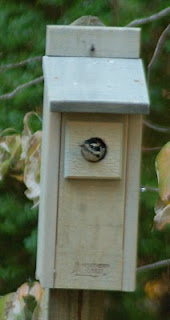But this week, we've got rain, rain, glorious rain! Station number VA-JC-12 reported .65 inch on September 27, .80 inch on September 28, .28 inch on September 29, and a whopping 5.72 inches today! Since reporting this morning, about 2 hours ago, I've accumulated another .20 of an inch. The goldfish and frogs are partying in the pond. Boy, do they love that fresh water.
 Yesterday afternoon I suited up in my foul weather gear and got to work on by serpentine channel in the easement rain garden . . . that I had to give up working on in June because of the hot weather. The earth out there had gotten to be as hard as a rock. But despite all of the rain this week, I quickly noted that the soil was still pretty doggone hard just a few inches down. I was amazed by the powdery dryness of the dirt.
Yesterday afternoon I suited up in my foul weather gear and got to work on by serpentine channel in the easement rain garden . . . that I had to give up working on in June because of the hot weather. The earth out there had gotten to be as hard as a rock. But despite all of the rain this week, I quickly noted that the soil was still pretty doggone hard just a few inches down. I was amazed by the powdery dryness of the dirt.So, when I got a message from Beth Davis reminding me that James City County water restrictions would be lifted on October 1 (see my May 4 post), but to still conserve water, I was not too surprised. Hear this, all ye James City County residents!
 My shower water collection goes on, because we've still got to keep the newer plants happy. I've tucked most of them under some mulch (sorry about that native bees) so this week's rain should hold them for awhile.
My shower water collection goes on, because we've still got to keep the newer plants happy. I've tucked most of them under some mulch (sorry about that native bees) so this week's rain should hold them for awhile.It's been a rough summer and when I complained about favorite native plants that I thought may not have survived the drought, my friend Jordan reminded me of the very feature of natives that makes them preferable: "Don't be too hasty to pull up those dead natives. They may have gone into survival mode, especially the milkweeds and the trumpet vines. My turtlehead looks awful but I am going to leave it alone and see what happens." Ah, and so we gardeners enter the soon to be plantless fall and winter seasons, all the while looking forward to rebirth in spring!
P.S. On October 1, my rain report was 4 inches for the preceding 24 hours. So, the total amount of rain that's fallen in James City County (Williamsburg, Virginia area) at my station this week is 11.45 inches. That's just a little over a half inch shy of a foot of rain in Williamsburg this week, in five days! Wow. I'm pretty sure that some of the other stations in James City County and Williamsburg reached the 1 foot of rain total this week.










































